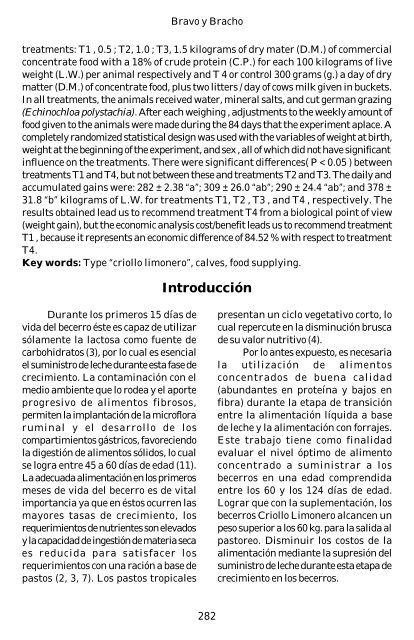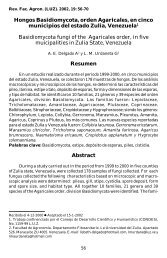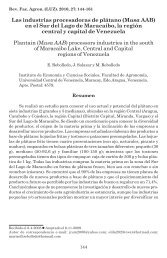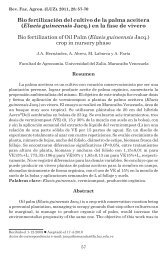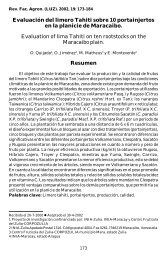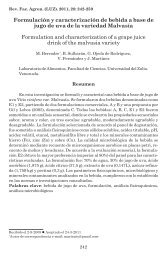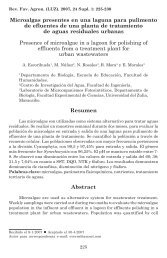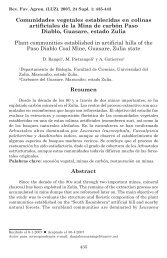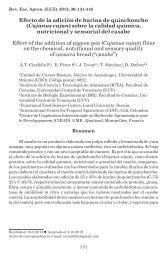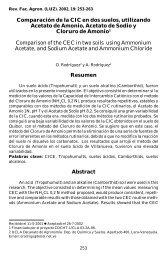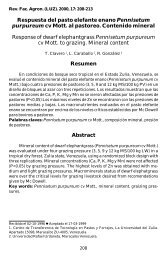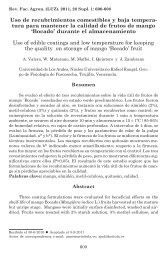Respuesta de becerros criollo limonero sometidos a diferentes ...
Respuesta de becerros criollo limonero sometidos a diferentes ...
Respuesta de becerros criollo limonero sometidos a diferentes ...
You also want an ePaper? Increase the reach of your titles
YUMPU automatically turns print PDFs into web optimized ePapers that Google loves.
Bravo y Bracho<br />
treatments: T1 , 0.5 ; T2, 1.0 ; T3, 1.5 kilograms of dry mater (D.M.) of commercial<br />
concentrate food with a 18% of cru<strong>de</strong> protein (C.P.) for each 100 kilograms of live<br />
weight (L.W.) per animal respectively and T 4 or control 300 grams (g.) a day of dry<br />
matter (D.M.) of concentrate food, plus two litters / day of cows milk given in buckets.<br />
In all treatments, the animals received water, mineral salts, and cut german grazing<br />
(Echinochloa polystachia). After each weighing , adjustments to the weekly amount of<br />
food given to the animals were ma<strong>de</strong> during the 84 days that the experiment aplace. A<br />
completely randomized statistical <strong>de</strong>sign was used with the variables of weight at birth,<br />
weight at the beginning of the experiment, and sex , all of which did not have significant<br />
influence on the treatments. There were significant differences( P < 0.05 ) between<br />
treatments T1 and T4, but not between these and treatments T2 and T3. The daily and<br />
accumulated gains were: 282 ± 2.38 “a”; 309 ± 26.0 “ab”; 290 ± 24.4 “ab”; and 378 ±<br />
31.8 “b” kilograms of L.W. for treatments T1, T2 , T3 , and T4 , respectively. The<br />
results obtained lead us to recommend treatment T4 from a biological point of view<br />
(weight gain), but the economic analysis cost/benefit leads us to recommend treatment<br />
T1 , because it represents an economic difference of 84.52 % with respect to treatment<br />
T4.<br />
Key words: Type “<strong>criollo</strong> <strong>limonero</strong>”, calves, food supplying.<br />
Introducción<br />
Durante los primeros 15 días <strong>de</strong><br />
vida <strong>de</strong>l becerro éste es capaz <strong>de</strong> utilizar<br />
sólamente la lactosa como fuente <strong>de</strong><br />
carbohidratos (3), por lo cual es esencial<br />
el suministro <strong>de</strong> leche durante esta fase <strong>de</strong><br />
crecimiento. La contaminación con el<br />
medio ambiente que lo ro<strong>de</strong>a y el aporte<br />
progresivo <strong>de</strong> alimentos fibrosos,<br />
permiten la implantación <strong>de</strong> la microflora<br />
ruminal y el <strong>de</strong>sarrollo <strong>de</strong> los<br />
compartimientos gástricos, favoreciendo<br />
la digestión <strong>de</strong> alimentos sólidos, lo cual<br />
se logra entre 45 a 60 días <strong>de</strong> edad (11).<br />
La a<strong>de</strong>cuada alimentación en los primeros<br />
meses <strong>de</strong> vida <strong>de</strong>l becerro es <strong>de</strong> vital<br />
importancia ya que en éstos ocurren las<br />
mayores tasas <strong>de</strong> crecimiento, los<br />
requerimientos <strong>de</strong> nutrientes son elevados<br />
y la capacidad <strong>de</strong> ingestión <strong>de</strong> materia seca<br />
es reducida para satisfacer los<br />
requerimientos con una ración a base <strong>de</strong><br />
pastos (2, 3, 7). Los pastos tropicales<br />
presentan un ciclo vegetativo corto, lo<br />
cual repercute en la disminución brusca<br />
<strong>de</strong> su valor nutritivo (4).<br />
Por lo antes expuesto, es necesaria<br />
la utilización <strong>de</strong> alimentos<br />
concentrados <strong>de</strong> buena calidad<br />
(abundantes en proteína y bajos en<br />
fibra) durante la etapa <strong>de</strong> transición<br />
entre la alimentación líquida a base<br />
<strong>de</strong> leche y la alimentación con forrajes.<br />
Este trabajo tiene como finalidad<br />
evaluar el nivel óptimo <strong>de</strong> alimento<br />
concentrado a suministrar a los<br />
<strong>becerros</strong> en una edad comprendida<br />
entre los 60 y los 124 días <strong>de</strong> edad.<br />
Lograr que con la suplementación, los<br />
<strong>becerros</strong> Criollo Limonero alcancen un<br />
peso superior a los 60 kg. para la salida al<br />
pastoreo. Disminuir los costos <strong>de</strong> la<br />
alimentación mediante la supresión <strong>de</strong>l<br />
suministro <strong>de</strong> leche durante esta etapa <strong>de</strong><br />
crecimiento en los <strong>becerros</strong>.<br />
282


